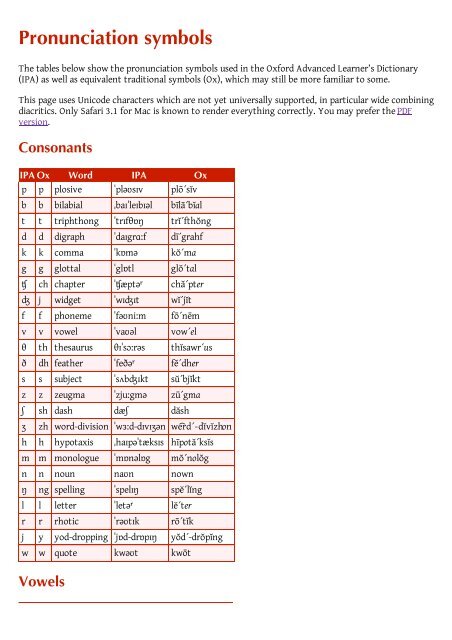Pronunciation symbols
Pronunciation symbols
Pronunciation symbols
Create successful ePaper yourself
Turn your PDF publications into a flip-book with our unique Google optimized e-Paper software.
<strong>Pronunciation</strong> <strong>symbols</strong><br />
The tables below show the pronunciation <strong>symbols</strong> used in the Oxford Advanced Learner’s Dictionary<br />
(IPA) as well as equivalent traditional <strong>symbols</strong> (Ox), which may still be more familiar to some.<br />
This page uses Unicode characters which are not yet universally supported, in particular wide combining<br />
diacritics. Only Safari 3.1 for Mac is known to render everything correctly. You may prefer the PDF<br />
version.<br />
Consonants<br />
IPA Ox Word IPA Ox<br />
p p plosive !pl"#s$v pl%´s&v<br />
b b bilabial 'ba$!le$b$"l b(l)´b&al<br />
t t triphthong !tr$f*+, tr&´fth-ng<br />
d d digraph !da$gr./f d(´grahf<br />
k k comma !k+m" k-´ma<br />
g g glottal !gl+tl gl-´tal<br />
0 ch chapter !0æpt"1 ch2´pter<br />
3 j widget !w$3$t w&´j&t<br />
f f phoneme !f"#ni/m f%´n4m<br />
v v vowel !va#"l vow´el<br />
* th thesaurus *$!s5/r"s th&sawr´us<br />
6 dh feather !fe6"1 f7´dher<br />
s s subject !s8b3$kt s9´bj&kt<br />
z z zeugma !zju/gm" z:´gma<br />
; sh dash dæ; d2sh<br />
< zh word-division !w=/d-d$v$
IPA Ox Word IPA Ox<br />
i/ 4 read ri/d r4d<br />
$ & syntax !s$ntæks s&´nt2ks<br />
e 7 text tekst t7kst<br />
æ 2 grammar !græm"1 gr2´mer<br />
./<br />
ah ideograph !$d$"gr./f &´d&ograhf<br />
# aide-mémoire 'e$d-'mem!w./1 $d-m%mw#´<br />
+ - cock k+k k-k<br />
5/<br />
aw talk t5/k tawk<br />
& corpus !k5/p"s c&´pus<br />
# ' book b#k b'k<br />
u/ toot ( tu/t t(t<br />
8 9 rubber !r8b"1 r9´ber<br />
=/ ! learn l=/n l!n<br />
"<br />
a alphabet !ælf"bet 2´lfab7t<br />
e literacy !l$t"r"s$ l&´terac&<br />
i pencil !pensl p7´nsil<br />
o colon !k"#l"n k%´lon<br />
u circumflex !s=/k"mfleks s!´kumfl7ks<br />
er author !5/*"1 aw´ther<br />
e$ ) paper !pe$p"1 p)´per<br />
"# % spoke sp"#k sp%k<br />
a$ ( write ra$t r(t<br />
a# ow umlaut !#mla#t '´mlawt<br />
5$ oi voiced v5$st voist<br />
$" ) gazetteer 'gæz"!t$"1 g2zet)´<br />
e" * swear swe"1 sw*<br />
#" oor plural !pl#"r"l ploor´al<br />
Remarks<br />
In addition to the <strong>symbols</strong> shown above, the traditional system also employs special <strong>symbols</strong> for some<br />
compound sounds, viz, + for ,er (a$"), owr for ower (a-.), / for y( (ju0) and 1 for yoor (j-.).<br />
In the IPA system, r’s are only written r when pronounced, and linking r’s (r’s which are only<br />
pronounced immediately before a word starting with a vocalic sound) are indicated by the special<br />
symbol 1. For vowel <strong>symbols</strong> in -r in the traditional system, the r is mute in front of a consonant, trilled<br />
before a vowel and linking at the end of a word, whereas other r’s are always pronounced.<br />
Sounds which share the same IPA symbol are usually indistinguishable.



